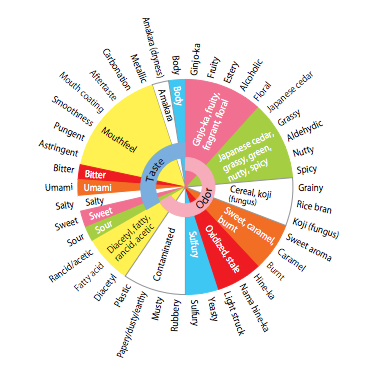Sommelier Talk: Episode 19 – Explicit Flavor Descriptions
The previous episode showed exemplary words to describe Sake aroma and texture. Let’s now move onto flavor description terminologies: sweet taste, acidity, bitter taste, and Umami.
Keeping in mind that Sake temperature can greatly influence the sensitivity of one’s palate, sake served at two varying temperatures will be quite different with a sake at 73 degrees F room temperature compared to bone-chilled sake at 32 degrees F, the warmer sake will be noticeably sweeter, and less on acidity and bitterness. That sweet taste increases with the rise in temperature, capping or maxing at 98 degrees Fahrenheit. Conversely, the acidity and bitter taste decreases with the temperature increase, however, there’s no big detectable difference between 50 to 104 degrees Fahrenheit. So, please take note and enjoy these subtle flavor differences at varying serving temperatures.
Moving on to “flavor descriptions”, see below for explicit words and adjectives, that can be used in conjunction to flavors to enhance understanding:
Sweet Taste: Refreshing, brisk, light, delicate, mild, velvety, rounded, soft, subdued, fluffy, dense
Acidity: Cool, soft, fresh, crisp, sharp, edgy, clean, rounded, firm, mellow, heavy
Bitter: Lively, sharp, mineral rich, clear, intense, thick, spicy, herby, earthy
Umami: Subtle, delicate, light, simple, soft, mild, rounded, velvety, overt, deep, bold, fluffy, mature, rich
Next are examples of words combination possibilities that can be used on a menu to describe product aroma and texture:
With aroma reminiscent of young apples and melon. This Junmai Ginjo from Hokkaido has a light texture with refreshingly sweet flavor, soft acidity and velvety Umami that languish elegantly.
Take special care of the overall taste structure and balance. Most sake sold at restaurants or liquor stores in the US are high quality, thus are well-balanced. This means that, there is no such Sake that are both light and velvety or Rich and airy at the same time because the two flavor characteristics are on two opposite ends of the flavor spectrum.
It’s good idea to open with an aromatic description. For fruity aroma, distinguish the aroma as a citrus, nut fruit, or a tropical fruit aroma, along with the maturity of that representative fruit such as “young melon”, “ripe melon”. Here again, take note of opposing characteristics that are not possible in a combination together such as “young lemon” with “ripe banana”. For sake with various layers of flower aromas, list the descriptions in order of light (white flower) to strong (red roses) aroma, followed by flavor and texture. The correct order of flavor listing follows the actual physical sensory signals that a person detects: sweet taste, acidity, bitter taste and Umami, followed by aftertaste.
One last note, in creating a Sake description for restaurants or a liquor stores, it’s always a good idea to include other people (staff, chefs, etc) in the flavor audit. It makes perfect sense to include sensory perceptions of others for a fair representation.


